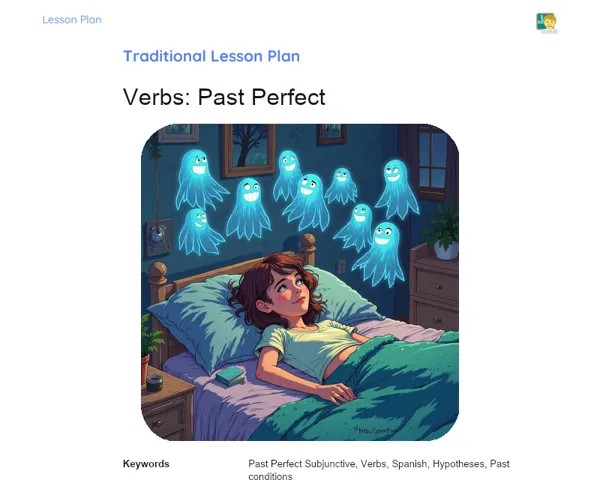Lesson Plan | Lesson Plan Tradisional | Verbs: Past Participle
| Keywords | Past Participle, Formation, Irregularities, Perfect Tenses, Passive Voice, Adjective, Spanish Grammar, Examples, Problem-Solving |
| Resources | Whiteboard, Markers, Projector, Presentation Slides, Activity Sheets, Pens, Notebooks |
Objectives
Duration: (10 - 15 minutes)
This stage introduces learners to the topic of the past participle in Spanish, focusing on the skills needed to understand and correctly use this grammatical concept. By clearly outlining the main objectives, the teacher sets a solid foundation for the lesson, ensuring students are aware of what to expect and are ready to concentrate on the key aspects of the content.
Objectives Utama:
1. Describe how the past participle is formed in Spanish.
2. Demonstrate the use of the past participle in various contexts.
3. Identify and correct improper uses of the past participle in sentences.
Introduction
Duration: (10 - 15 minutes)
The purpose of this stage is to introduce students to the topic of the past participle, establishing a clear and engaging context for the content to be discussed. By providing background information and interesting facts, the teacher can capture the students' attention and prepare them for active participation in the lesson.
Did you know?
📜 Did you know that many past participles in Spanish share similarities with those in Portuguese? This can significantly simplify the learning journey. Furthermore, correctly using the past participle is essential in both academic and professional environments, as it reflects a more advanced grasp of the language.
Contextualization
Explain to the students that the past participle is a verb form that plays a vital role in various grammatical structures in Spanish. It's mainly used to create perfect tenses, such as the present perfect, as well as in passive and adjectival constructions. For instance, in the phrase 'He comido', 'comido' serves as the past participle of the verb 'comer'. This concept is crucial for a comprehensive understanding and correct application of Spanish, particularly in written and formal contexts.
Concepts
Duration: (50 - 60 minutes)
The purpose of this stage is to provide a detailed and practical understanding of the use of the past participle in Spanish. By addressing its formation, irregularities, and application in different grammatical contexts, the teacher helps students develop the necessary skills to use this verb form accurately. Furthermore, practical questions encourage learners to apply the knowledge gained, reinforcing their learning.
Relevant Topics
1. Formation of the Past Participle: Explain that the past participle in Spanish is generally formed by adding '-ado' for verbs ending in '-ar' and '-ido' for verbs ending in '-er' and '-ir'. For example, 'hablar' becomes 'hablado' and 'comer' becomes 'comido'.
2. Common Irregularities: Mention that some Spanish verbs have irregular past participles that do not adhere to the typical formation rules. Examples include 'decir', which becomes 'dicho', and 'hacer', which turns into 'hecho'.
3. Use of the Past Participle in Perfect Tenses: Show how the past participle is used in perfect tenses, like the present perfect. For example, 'Yo he comido' (I have eaten).
4. Past Participle in Passive Voice: Explain how the past participle functions in passive voice to indicate that the action was conducted on the subject. For instance, 'La carta fue escrita por Juan' (The letter was written by Juan).
5. Past Participle as Adjective: Demonstrate how the past participle can serve as an adjective, agreeing in gender and number with the noun. For example, 'La puerta está cerrada' (The door is closed).
To Reinforce Learning
1. Transform the following regular verbs into past participles: 'hablar', 'comer', 'vivir'.
2. Identify the irregular past participles in these sentences: 'He escrito una carta', 'Has visto la película'.
3. Create a sentence using the past participle in the present perfect tense with the verb 'leer'.
Feedback
Duration: (15 - 20 minutes)
The objective of this stage is to review and consolidate the knowledge the students have acquired during the lesson, ensuring they have a clear grasp of the explanations and can correctly apply the past participle in various contexts. The discussion of responses and reflective questions promotes a collaborative and critical learning environment.
Diskusi Concepts
1. 📜 Question 1: Transform the following regular verbs into past participles: 'hablar', 'comer', 'vivir'. 2. For regular verbs, the past participle is created by adding '-ado' for '-ar' verbs and '-ido' for '-er' and '-ir' verbs. Thus, 'hablar' becomes 'hablado', 'comer' becomes 'comido', and 'vivir' becomes 'vivido'. 3. 📜 Question 2: Identify the irregular past participles in the following sentences: 'He escrito una carta', 'Has visto la película'. 4. In 'He escrito una carta', the irregular past participle is 'escrito', derived from the verb 'escribir'. In 'Has visto la película', the irregular past participle is 'visto', which comes from the verb 'ver'. 5. 📜 Question 3: Create a sentence using the past participle in the present perfect tense with the verb 'leer'. 6. A potential sentence could be 'He leído el libro', where 'leído' is the past participle of 'leer'.
Engaging Students
1. 🤔 Question 1: Why is it important to identify irregular past participles? 2. 🤔 Question 2: How can the past participle used as an adjective enhance writing in Spanish? 3. 🤔 Question 3: What challenges might one face when forming and using the past participle? How can we tackle these? 4. 🤔 Question 4: Encourage students to create an original sentence employing an irregular past participle. 5. 🤔 Question 5: Discuss how understanding the past participle can enrich comprehension of Spanish texts.
Conclusion
Duration: (10 - 15 minutes)
This stage aims to solidify learning, ensuring that students have understood the key points discussed in the lesson. The review of content helps reinforce knowledge, while discussing the practical significance of the topic motivates students to apply what they've learned in real-life situations.
Summary
["The past participle in Spanish is formed by adding '-ado' for verbs ending in '-ar' and '-ido' for those ending in '-er' and '-ir'.", "Some verbs exhibit irregular past participles, such as 'decir' (dicho) and 'hacer' (hecho).", 'The past participle is utilized in perfect tenses, such as the present perfect, in passive constructions, and as an adjective.', 'When the past participle functions as an adjective, agreement in gender and number is essential.']
Connection
In this lesson, the theoretical aspects of the formation and usage of the past participle were directly linked to practice through examples and exercises. Students applied their newfound knowledge in various activities, which reinforced their understanding and capability to use the past participle correctly across different grammatical contexts.
Theme Relevance
Mastering the past participle is crucial for achieving fluency in Spanish, particularly in academic and professional settings. Knowing how to use this verb form accurately enhances both written and spoken communication, enabling students to express more sophisticated ideas and better comprehend complex texts.


